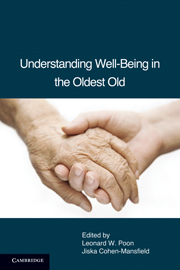Book contents
- Frontmatter
- Contents
- List of Tables
- List of Contributors
- Foreword by Carol D. Ryff
- PART I THEORY: NEW HORIZONS IN WELL-BEING RESEARCH
- PART II PARADISE LOST: BETWEEN TRAUMA AND HAPPINESS
- PART III PATHWAYS AND GATEKEEPERS: MODERATING, MEDIATING, AND PROXIMAL PROCESSES
- 9 Impact of Resources on Successful Adaptation among the Oldest Old
- 10 Nutrition and Well-Being
- 11 Cognitive Functioning and Vitality among the Oldest Old: Implications for Well-Being
- 12 Social Relationships and Well-Being in Very Late Life
- 13 Spirituality and Religiosity Connections to Mental and Physical Health among the Oldest Old
- 14 The Impact of Leisure Activity and Innovation on the Well-Being of the Very Old
- PART IV SIGNPOSTING PARADISE: MEASUREMENT OF WELL-BEING
- Index
- References
14 - The Impact of Leisure Activity and Innovation on the Well-Being of the Very Old
Published online by Cambridge University Press: 05 August 2012
- Frontmatter
- Contents
- List of Tables
- List of Contributors
- Foreword by Carol D. Ryff
- PART I THEORY: NEW HORIZONS IN WELL-BEING RESEARCH
- PART II PARADISE LOST: BETWEEN TRAUMA AND HAPPINESS
- PART III PATHWAYS AND GATEKEEPERS: MODERATING, MEDIATING, AND PROXIMAL PROCESSES
- 9 Impact of Resources on Successful Adaptation among the Oldest Old
- 10 Nutrition and Well-Being
- 11 Cognitive Functioning and Vitality among the Oldest Old: Implications for Well-Being
- 12 Social Relationships and Well-Being in Very Late Life
- 13 Spirituality and Religiosity Connections to Mental and Physical Health among the Oldest Old
- 14 The Impact of Leisure Activity and Innovation on the Well-Being of the Very Old
- PART IV SIGNPOSTING PARADISE: MEASUREMENT OF WELL-BEING
- Index
- References
Summary
ABSTRACT
This chapter discusses the role of leisure in the well-being in the old and the oldest old and, in particular, the potential benefit of innovative activity. Using a case study approach, this chapter demonstrates that innovation (i.e., adding a brand new activity into one's life) is possible even under extreme health constraints, and that its benefits may be quite diverse. Innovation seems to offer relief and distraction from physical and emotional losses, and creates an opportunity for a more meaningful daily life. It is consequently suggested that innovation at a very old age may contribute to an enhanced sense of well-being.
WHAT IS LEISURE?
Defining leisure may seem an easy task, but scholars often refer to different phenomena while using the same terminology. The most common concepts associated with leisure are: time, activity, and experience (Katz et al., 2000; Kelly, 1996). When defining leisure as time, writers refer to it as residual, or leftover, time. This time is what is left after completing all duties (e.g., work and home chores) and necessary activities (e.g., eating and sleeping). This time is distinctive by being relatively free from obligations and by a high level of choice.
- Type
- Chapter
- Information
- Understanding Well-Being in the Oldest Old , pp. 240 - 258Publisher: Cambridge University PressPrint publication year: 2011
References
- 11
- Cited by

